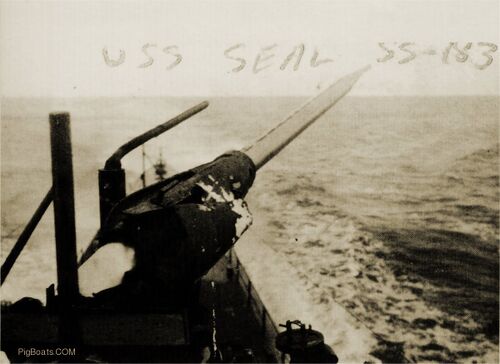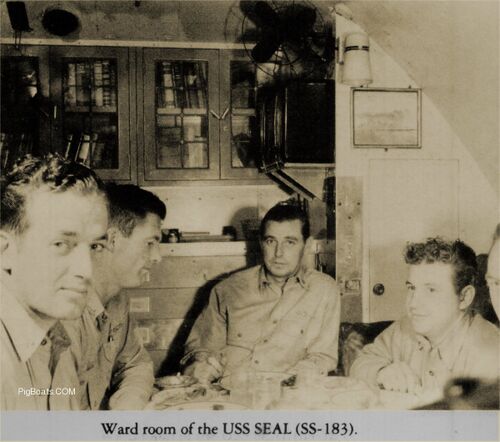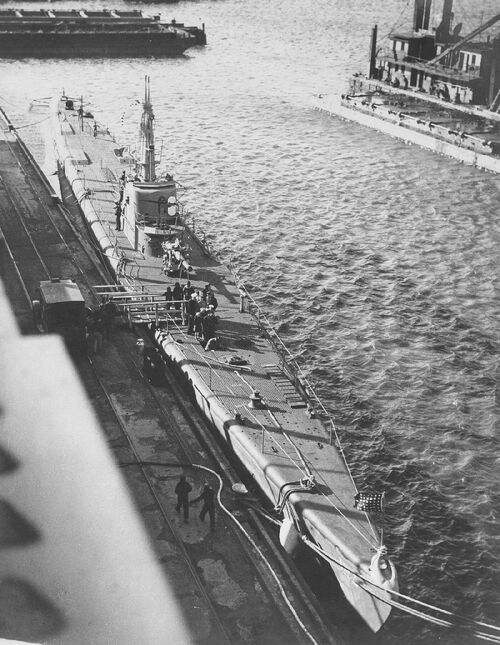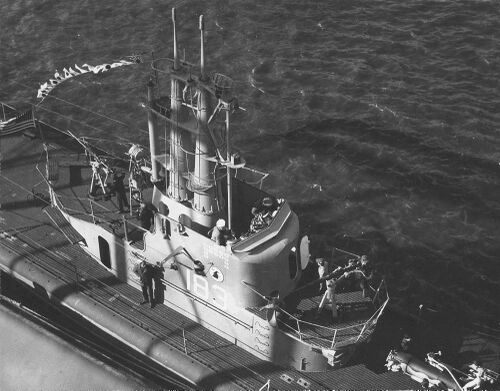183

Photo 19-N-19022 courtesy of NHHC.

Seal shown arriving at Submarine Base New London, CT., April 1938. There are civilians riding her, all employees of the Electric Boat Company downriver where Seal was built. The tall man leaning against the rail on deck is likely Lawrence Y. Spear, Electric Boat's legendary designer and Vice President. He had been with the company since 1902 and had taken over as chief designer from John Holland. He later passed on the chief designer title to the brilliant Hugo E. Grieshaber, who is the man above Spear on the right, leaning against the cigarette deck bulwark.
Photo NH 103421 courtesy of NHHC.

While conducting her 5th war patrol on November 16, 1942, under the command of LCDR Kenneth C. Hurd, the Seal had a "bad moment" and was run down by a Japanese merchant ship. Seal survived but it is unknown if the Japanese ship sank. She was at the lest badly damaged. According to Seal's war report, "...quantities of uncooked rice and beans, unlike those used on the submarine, were found between the wooden deck pieces of the cigarette deck, on the bridge, and caught in the bathythermograph. The periscope shears yielded a good sample of Japanese bottom paint."
Seal's War Damage Report Summary reads: "While at 61-foot depth and only twelve seconds after firing torpedoes at a Japanese freighter, Seal was run down by a second Japanese cargo ship which passed directly overhead and damaged the periscopes, radar, and their supporting shears. Boat rose from 61 feet to 55 feet due to suction effect and hung there for nearly a minute before starting down. No. 2 periscope, which was fully extended, was bent nearly horizontal at top of shears. SD radar mast was also bent over in same direction. No. 1 periscope could not be operated due to misalignment of upper bearings. No. 2 periscope housing was broken off level with top of housing for No. 1 periscope. No other damage occurred. Patrol was terminated."
With this event the Japanese knew the submarine was there and began a search and as the Seal leveled off at 250 feet depth charges began dropping from the escort ships. Soon breaking up noises were heard but whether they were from the damaged cargo ship sinking was unknown at the time. After four hours at depth things began quieting down, the Japanese perhaps thinking the Seal sunk from the collision. Seal surfaced and departed the area and began assessing her damages. After the war's end it was reported that the torpedoes fired just before the collision gave these results: "...confirmed the sinking of the 3,500-ton freighter BOSTON MARU by an American submarine on that date in that location."
This photo shows the bent periscopes and shears, taken on November 17 as the Seal departed the area.
Photo courtesy of USSVI WWII.

A photo taken in the wardroom of the Seal. The date of the photo is not known for certain but it can be placed between 1943 and mid 1944. The man in the middle is the Seal's Commanding Officer, LCDR Harry B. Dodge along with other unidentified officers. Dodge is sitting in the Captain's chair which was located at the aft end of the wardroom table. The most senior officers sat near the captain and least senior sat at the opposite or forward end of the table.
The cabinetry behind Dodge held, as seen, books of all kinds from recreational to technical books. The cabinet below had drawers that held charts and much of the wardroom silver service and dishes and serving plates and bowls. A large fan can be seen above Dodge's head.
The photo was taken after a meal had been served and before the Steward had cleared away the dirty dishes. An ashtray can be seen next to Dodge's right hand. The man to the right of Dodge could possibly be the Seal's Executive Officer, LT Robert Duryea. He is sitting in the seat usually occupied by a ship's Executive Officer. Especially if this photo was taken right after a meal the officers would be sitting in their allocated seating and he is wearing Lieutenant's bars.
Following Navy protocol, the officer to Dodge's left would be the Engineering Officer and the man closest to the camera on Dodge's right would be the Operations Officer. The man barely seen at the far right of the photo would probably be the Weapons Officer. Photo could possibly be taken by the Commissary Officer as it is taken from a seated position. Commissary Officers were the least senior of officers and sat at the far end opposite the captain. The photo could possibly have been taken by a Steward.
Photo courtesy of USSVI WWII.

Seal is seen here most likely in Boston, MA., circa November 1945 prior to her decommissioning. She is open to the public. She is flying her "kill flags" from the after periscope lookout railing. There are visitors entering the sub via the forward escape trunk access. Seal has received the full suite of wartime modifications, and at this point is a fairly modern boat. Her biggest limitations were having only eight torpedo tubes and a 250 foot test depth.
U.S. Navy photo.

Salmon (SS-182), Seal, and Skipjack (SS-184) all received similar wartime upgrades. They all received new conning towers and a completely rebuilt fairwater that made them strongly resemble the much newer Balao-class boats. This photo shows Seal alongside in Boston just after the end of the war sporting all of these upgrades. She has 20 mm guns on the tripod style Mk 10 mounts on the forward and aft fairwater gun decks, SJ radar forward of the completely rebuilt periscope shears, two 40-foot periscopes, and SD radar on a mast aft of the shears. just visible in the lower right is a 4"/50 caliber Mk 9 gun, a much more powerful gun than the original 3"/50 she was built with.
U.S. Navy photo.
Page created by:
Ric Hedman & David Johnston
1999 - 2023 - PigBoats.COM©
Mountlake Terrace, WA, Norfolk, VA
webmaster at pigboats dot com
